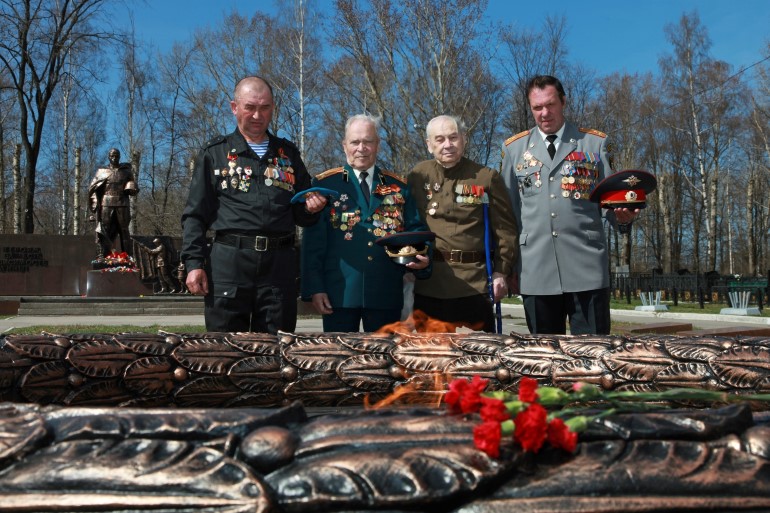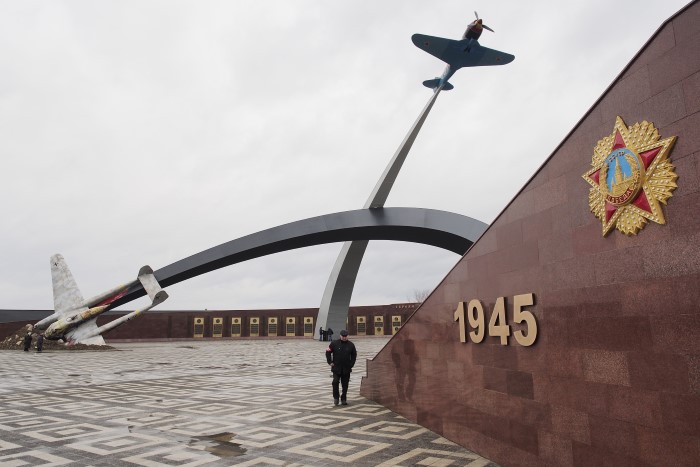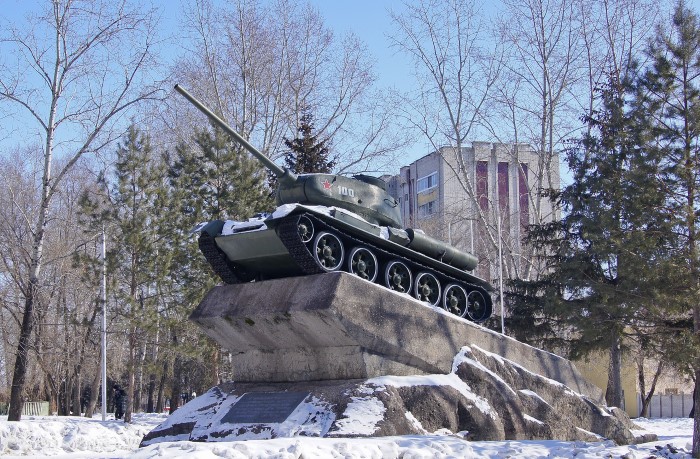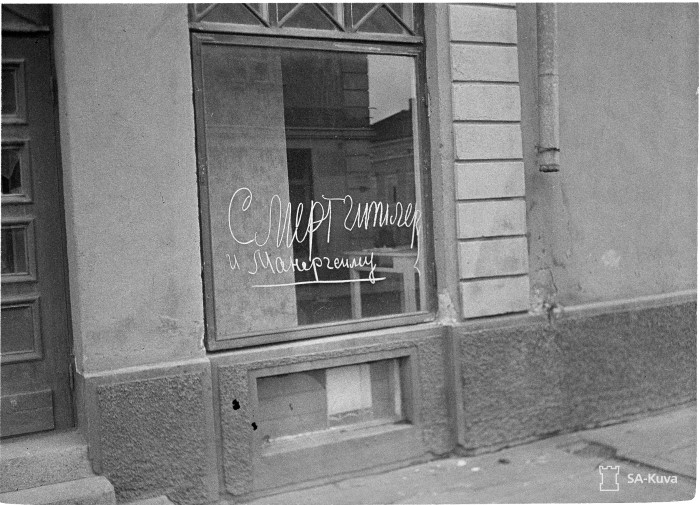
Walking After Letters from the Front
/ Главная / Russkiy Mir Foundation / Publications / Walking After Letters from the FrontWalking After Letters from the Front
Sergei Vinogradov

Photo: Iuri Kashin
Letters from the front constitute the basis for new tourist routes that are opening in various parts of Russia this year. The eight winners have been announced in a contest for historical military routes called “Take pride, country, in your valiant sons!” Sightseers visit memorable locations connected to World War Two, which are described by those who participated in these events in letters to their loved ones. The authors of three winning routes gave tours to a correspondent from Russkiy Mir.
Viewing history through the testimony of those who lived it isn’t a new idea. But it’s one thing when professional writers convey the reality of the trenches, and it’s another thing to encounter the personal letters of simple soldiers, who described what was happening to their relatives and loved ones. Serving as the basis for these tours, these letters allow one to see the World War Two from another point of view, to see for oneself a quiet and unassuming kind of everyday heroism.
Contestants created projects allowing a contemporary person to hear the voices of those who fought, to learn about the life of a city during the war years, and to see with new eyes the streets, squares, and houses where dramatic events occurred. The contest demonstrated that not only can the topic of war foster patriotism and promote interest in the nation’s history, but it can also become the basis for a successful tourism venture.
“Hi. I’m well. I’m fighting.”
Tula is a city of gunsmiths. Since the 14th century, there probably hasn’t been a single Russian war in which Tula didn’t either join the fight itself by repelling attacks or provide the army with weapons and training for the soldiers. World War II descended on the citizens of Tula in full force: Tula has the title of a “hero city.”
“Hi. I’m well. I’m fighting. Vasily.” These words are all that Tula resident Vasily Khlebtsov wrote in one of his last letters. He was the commander of the 110th infantry division, which fought in Mogilev during the first weeks of the war. The tour guide of Tula regional museum, Dmitry Timachev, chose these words as the title for the historical tour route he created. “Vasily Khlebstov wrote these lines under fire; it was a real hell there at that time,” says the museum worker. “Our route narrates the contribution made by Tula residents to the nation’s victory. We uncover the fate of people who took part in defending Tula.”

Tula—Memorial “Defenders of the Skies of the Fatherland"
Photo provided by the Tula regional museum
While preparing the route, Dmitry Timachev studied the several hundred letters from the front held in the collections of the regional museum. “What was I looking for in those letters? A human note that would reveal the experience of a soldier and touch people; one that would evoke understanding and sympathy,” says Dmitry. “On the basis of these letters, I put together the route along which buses take visitors down city streets.”
The tour will open in September/October of this year. At present, its author and the museum are finishing the script and preparing to produce souvenirs. Tour-takers will visit memorials and museums (including the reconstructed armored train No. 13, The Tula Worker), and they will see original letters on exhibit, as well as locations of battle. Over the full course of the journey, participants will hear citations from the letters of Tula residents who fought in the war. For instance, the stories of pilots who perished in battle at Tula will be read at the Defenders of the Skies of the Fatherland monument. And at the Vsekhsvyatskoye Cemetery—where the city’s line of defense ran and today the location of communal graves (one can see walled-in machine gun embrasures and bullet traces)—they will confidingly read lines from the letters of those who participated in these battles.
“This letters reveal astonishing people and their fates,” says Dmitry. “Take for example the commander of a fighter aviation regiment, the pilot Semyon Orliakhin. I could talk about him for a long time, but I’ll say simply that he was truly a tough guy. He downed nine enemy planes, was awarded with three Orders of the Wartime Red Banner and an Order of the British Empire. But he wrote touching and penetrating letters. If you tell his story properly to young people, they won’t want to know anything about Hollywood superheroes.
“One would think that one might find some complaints or nervous breakdowns in letters written by people who are under fire to their families—something like, ‘it’s unbearable here, I can’t go on.’ But I haven’t encountered anything like it in letters from the front,” says the tour guide. “The majority of them are touching, exuding care and humanity. At such a moment people write about what’s most important—their family and home—without talking about their hardships.”
A Letter to the Far East
World War II spared the streets of Khabarovsk, but there are quite a few monuments to the soldiers and home front laborers in this city. The contest for tourist historical military routes and the grant they won allowed the workers at the N. I. Grodekov Khabarovsk Regional Museum conduct bus tours of the major wartime sights in a city that didn’t fight. Lines in the letters of front-line soldiers incorporated individual streets and buildings in Khabarovsk into the history of World War II.
“In 2015 the museum published a catalogue including 187 letters from soldiers on the front, which are held in our collections,” recounted Anna Averina, the manager of the research division of the Khabarovsk museum and the author of the project “Letters of the War Years/Following Lines of Correspondence.” “Among them are the letters of Khabarovsk residents who went to fight, as well as those residents who stayed in the city during the war years. And when we learned about the contest hosted by the Russian Military Historical Society, we decided to make a tour route based on the materials in our catalogue.”

Khabarovsk—Monument to a Tank. Photo provided by the Khabarovsk regional museum
The route runs through museums and monuments to war heroes, and the bus will also stop at the houses to which the wartime letters were addressed and where heroes of World War II lived. Buildings and streets that provided aid to the front are also part of the tour—and factories as well.
“I was struck by the story of a young woman from Khabarovsk named Zinaida Savchenko, the brigadier of a factory where tanks were repaired,” Anna Averina tells me. “In 1943 the Soviet Patriot newspaper published a comment about a woman who fulfilled 300 percent of her quota. And the factory received letters from all over the Soviet Union. People wrote from the trenches, from the front, from everywhere. We will read those letters during the tour, and there’s a stop at the monument to the T-34 tank, which was repaired at our factory.
Where the Dawns are Quiet
Thirty kilometers from the town of Sortavala are the Ruskeala Canyon and the Akhvenokoski waterfall, where the legendary film The Dawns are Quiet Here was shot. Every year, thousands of people come to these places to see the stones from which Senior Sargent Vaskov and the female anti-aircraft gunners counted the enemy intruders, and to dive into the waters where the soldier Zhenia Komelkova bathed—and of course, to listen to the quite of the Karelian nights.
Sortavala saw battles and exchanged hands during the war years. In this Karelian town there are several museums connected to the Finnish and Second World Wars, but there wasn’t a decent tourist route that brought together all the commemorative sights. The plan for “Heroes of Sortavala—On the Path of War,” made by the Sortavala Leisure Center and the city search committee, was declared by the jury in the contest for historical military routes as the best in the Northwest. The project’s author, Elena Riazantseva, hopes that fans of war films and those interested in history will now have a new reason for coming besides the “dawns” and waterfalls.
The tour route will open in July and operate in the summer and autumn. During the tour of Sortovala the bus stops eight times: in the Zaria movie theater, by the officers’ garrison, and at Väinämöinen Square, where the headquarters of the Soviet divisions, as well as frontier and partisan bands, were stationed during the war. The theater will roll out an exhibit of discoveries by local scavengers: Here, one will find arms, ammunition, shells fragments, and many other items belonging to soldiers in the Soviet, German, and Finnish armies.

Caption: "Death to Hitler and Mannerheim." Sortavala, August 1941.
Photo provided by the Leisure Center (Sortavala)
Tourists will also be told that there used to be a Protestant church where the Sortavala boarding school stands, but it was destroyed in an air bombing. They will also be shown the view of Sortavala from the Kukhavuori mountain—during the raid on the city, there were fierce battles for a height advantage here. One of the locations on the tour will be the Finnish military cemetery. “Our city library also seriously suffered from shooting by the Finnish army in 1941,” recounted Elena Riazantseva. “And the traces of bullets and missiles that still remain on the building’s façade make a deep impression on people. We see this in the tour groups.”
The goal of the museum workers and developers of this route is to help people see in the bullet holes, lines from letters by long-dead soldiers, and old graves the real events of a terrible war and the real people who fought and loved.
The winners of the contest were:
-
“Hello. I’m well. I’m fighting…” Tula;
-
“The Heroes of Sortavala—On the Path of War,” Karelia;
-
“Birthplace of Heroes of the Soviet Union: Kungur to the Front,” Perm;
-
“They Defended the Motherland: The Names on the Obelisks,” Rostov;
-
“The Path of Courage and Mercy,” Stavropol;
-
“The Tyumen Wings of Victory,” Tyumen;
-
“At the Very End,” Tomsk;
-
“Letters of the War Years/Following Lines of Correspondence,” Khabarovsk.
New publications

 Mikhail Kalatozov, a director who transformed the world of cinematography in many ways, was born 120 years ago. He was a Soviet film official and a propagandist. Above all, he was capable of producing movies that struck viewers with their power and poetic language.
Mikhail Kalatozov, a director who transformed the world of cinematography in many ways, was born 120 years ago. He was a Soviet film official and a propagandist. Above all, he was capable of producing movies that struck viewers with their power and poetic language.  Ukrainian authorities have launched a persecution campaign against the canonical Ukrainian Orthodox Church (UOC), the biggest one in the country's modern history. Over the past year, state sanctions were imposed on clergy representatives, searches were conducted in churches, clergymen were arrested, criminal cases were initiated, the activity of the UOC was banned in various regions of the country, and monasteries and churches were seized.
Ukrainian authorities have launched a persecution campaign against the canonical Ukrainian Orthodox Church (UOC), the biggest one in the country's modern history. Over the past year, state sanctions were imposed on clergy representatives, searches were conducted in churches, clergymen were arrested, criminal cases were initiated, the activity of the UOC was banned in various regions of the country, and monasteries and churches were seized.  When Nektary Kotlyaroff, a fourth-generation Russian Australian and founder of the Russian Orthodox Choir in Sydney, first visited Russia, the first person he spoke to was a cab driver at the airport. Having heard that Nektariy's ancestors left Russia more than 100 years ago, the driver was astonished, "How come you haven't forgotten the Russian language?" Nektary Kotlyaroff repeated his answer in an interview with the Russkiy Mir. His affinity to the Orthodox Church (many of his ancestors and relatives were priests) and the traditions of a large Russian family brought from Russia helped him to preserve the Russian language.
When Nektary Kotlyaroff, a fourth-generation Russian Australian and founder of the Russian Orthodox Choir in Sydney, first visited Russia, the first person he spoke to was a cab driver at the airport. Having heard that Nektariy's ancestors left Russia more than 100 years ago, the driver was astonished, "How come you haven't forgotten the Russian language?" Nektary Kotlyaroff repeated his answer in an interview with the Russkiy Mir. His affinity to the Orthodox Church (many of his ancestors and relatives were priests) and the traditions of a large Russian family brought from Russia helped him to preserve the Russian language.

 The leaders of the Friends of the Great Russia cultural association (Amici Della Grande Russia) in Italy believe that the Western policy of abolishing Russian culture in Europe has finally failed. Furthermore, it was doomed to failure from the beginning.
The leaders of the Friends of the Great Russia cultural association (Amici Della Grande Russia) in Italy believe that the Western policy of abolishing Russian culture in Europe has finally failed. Furthermore, it was doomed to failure from the beginning.  Name of Vladimir Nemirovich-Danchenko is inscribed in the history of Russian theater along with Konstantin Stanislavski, the other founding father of the Moscow Art Theater. Nevertheless, Mr. Nemirovich-Danchenko was a renowned writer, playwright, and theater teacher even before their famous meeting in the Slavic Bazaar restaurant. Furthermore, it was Mr. Nemirovich-Danchenko who came up with the idea of establishing a new "people's" theater believing that the theater could become a "department of public education."
Name of Vladimir Nemirovich-Danchenko is inscribed in the history of Russian theater along with Konstantin Stanislavski, the other founding father of the Moscow Art Theater. Nevertheless, Mr. Nemirovich-Danchenko was a renowned writer, playwright, and theater teacher even before their famous meeting in the Slavic Bazaar restaurant. Furthermore, it was Mr. Nemirovich-Danchenko who came up with the idea of establishing a new "people's" theater believing that the theater could become a "department of public education."  "Russia is a thing of which the intellect cannot conceive..." by Fyodor Tyutchev are famous among Russians at least. December marks the 220th anniversary of the poet's birth. Yet, he never considered poetry to be his life's mission and was preoccupied with matters of a global scale. Mr.Tyutchev fought his war focusing on relations between Russia and the West, the origins of mutual misunderstanding, and the origins of Russophobia. When you read his works today, it feels as though he saw things coming in a crystal ball...
"Russia is a thing of which the intellect cannot conceive..." by Fyodor Tyutchev are famous among Russians at least. December marks the 220th anniversary of the poet's birth. Yet, he never considered poetry to be his life's mission and was preoccupied with matters of a global scale. Mr.Tyutchev fought his war focusing on relations between Russia and the West, the origins of mutual misunderstanding, and the origins of Russophobia. When you read his works today, it feels as though he saw things coming in a crystal ball...